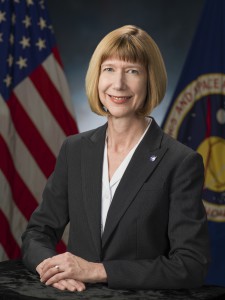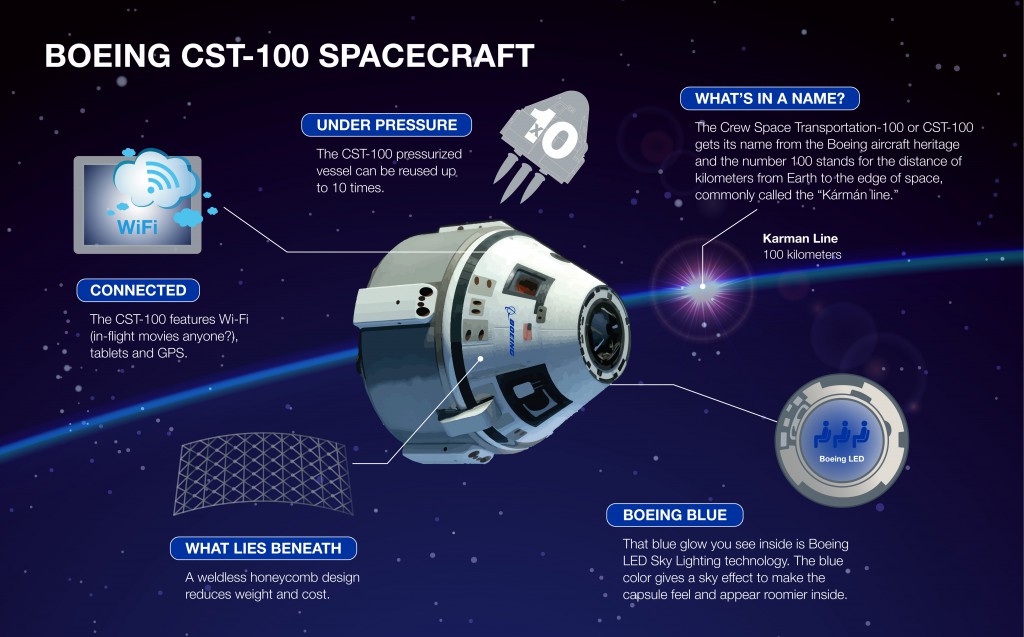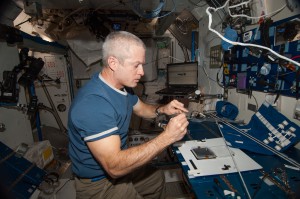Boeing continues to develop the CST-100 in partnership with NASA’s Commercial Crew Program. The spacecraft is designed to launch humans to low-Earth orbit and return them safely. The aerospace company says it is drawing from its experiences designing airliners for CST-100’s interior and other elements of the new spacecraft.
Category: Commercial Spaceflight
NASA: Explorers Seek Adventure
Space Station Science Forum Today on NASA TV
Researchers and NASA managers will discuss details today about the extensive array of scientific work that has been under way on the International Space Station during an hourlong forum to be broadcast on NASA TV beginning at 3:30 p.m. EDT.
The research covers a wide area of specialties and specific experiments are chosen for inclusion in the station’s manifest based on a wide number of criteria. The factors include evaluating how the research can help NASA understand and prepare for the conditions humans will face when astronauts venture beyond Earth orbit in coming years to explore asteroids and Mars.
NASA’s Commercial Crew Program could enable a boost in the amount of future research on the orbiting laboratory by allowing a larger crew to work on the station, thus increasing the amount of time astronauts can devote to scientific duties.
Watch NASA TV to find out more, or go to www.nasa.gov/ntv to watch online.
What Name Would You Choose?

Alan Shepard was the first astronaut to name his spacecraft. He chose “Freedom 7,” a reference to the space race that was just starting between the United States and the Soviet Union when Shepard went into space on May 5, 1961. Since then, astronauts named each of their spacecraft including the iconic “Eagle” that landed men on the moon for the first time in 1969. NASA dubbed its five space shuttles Columbia, Challenger, Discovery, Atlantis and Endeavour. The next generation of crewed spacecraft built by NASA’s industry partners chose Space Vehicle (Blue Origin), CST-100 (Boeing), Dream Chaser (Sierra Nevada Corporation) and Dragon (SpaceX). If you had a spacecraft, what would you name it?
Bloomberg TV’s “The Next Space Race”
 Bloomberg Television took an up-close look at the work NASA’s industry partners are performing to produce the next American spacecraft capable of carrying humans to low-Earth orbit destinations. Bloomberg examined NASA’s partnerships with The Boeing Company, Sierra Nevada Corporation and SpaceX and what the effort means to America’s goals in space exploration. You can watch the full 23-minute report here.
Bloomberg Television took an up-close look at the work NASA’s industry partners are performing to produce the next American spacecraft capable of carrying humans to low-Earth orbit destinations. Bloomberg examined NASA’s partnerships with The Boeing Company, Sierra Nevada Corporation and SpaceX and what the effort means to America’s goals in space exploration. You can watch the full 23-minute report here.
Miss Kathy Lueders’ Interview? Watch it now
Kathy Lueders, manager of NASA’s Commercial Crew Program, talked to Kyle Herring at Mission Control in Houston for this segment of Space Station Live. She details the plans and expectations for CCP and how they fit in with NASA’s overall stepping-stone approach for astronauts to explore deeper into space.
Spaceport Magazine Includes SNC Wind Tunnel Testing
 Open the newest issue of Kennedy Space Center’s Spaceport Magazine to read about the detailed work that goes into testing spacecraft models, in this case the Dream Chaser under development by Sierra Nevada Corporation in partnership with NASA’s Commercial Crew Program. This is the second edition of the redesigned publication, and it also includes stories about the launch of the SpaceX-3 cargo resupply mission to the International Space Station, Firing Room 4’s metamorphosis and NASA’s plans to develop the capabilities needed to send humans to an asteroid by 2025. It’s available in the digital newsstand and at Spaceport Magazine.
Open the newest issue of Kennedy Space Center’s Spaceport Magazine to read about the detailed work that goes into testing spacecraft models, in this case the Dream Chaser under development by Sierra Nevada Corporation in partnership with NASA’s Commercial Crew Program. This is the second edition of the redesigned publication, and it also includes stories about the launch of the SpaceX-3 cargo resupply mission to the International Space Station, Firing Room 4’s metamorphosis and NASA’s plans to develop the capabilities needed to send humans to an asteroid by 2025. It’s available in the digital newsstand and at Spaceport Magazine.
Watch Kathy Lueders on Space Station Live at 11 Today
 Tune in to Space Station Live on NASA TV at 11 a.m. EDT to see Kathy Lueders’ interview about NASA’s Commercial Crew Program and how it is progressing. Lueders was recently named manager of CCP. You can watch NASA TV on your provider or catch it online at nasa.gov/ntv.
Tune in to Space Station Live on NASA TV at 11 a.m. EDT to see Kathy Lueders’ interview about NASA’s Commercial Crew Program and how it is progressing. Lueders was recently named manager of CCP. You can watch NASA TV on your provider or catch it online at nasa.gov/ntv.
Commercial Crew: Part of NASA’s Stepping Stone Approach to Human Exploration
 By Kathy Lueders,
By Kathy Lueders,
Commercial Crew Program Manager
This is an exciting time to become a program manager in NASA’s human spaceflight program. We have already introduced a new way to develop spacecraft for low-Earth orbit with the cargo program. This is our stone in the overall agency’s stepping stone approach to unprecedented exploration. First, regular trips to the International Space Station aboard privately owned, American-made spacecraft so we can get the most out of the orbiting laboratory and its one-of-a-kind research capabilities, then human excavation of an asteroid in space followed by the boldest mission yet: sending humans to Mars. The Commercial Crew Program is committed to meeting our part of this critical strategy.
The Commercial Crew Program was created three years ago with two purposes. The first is to invest in a national capability for flying crews to low-Earth orbit. During the past three years, using the investment NASA has provided, the partners have risen to the challenge and have made tremendous progress toward developing safe, reliable and cost-effective space transportation systems for low-Earth orbit. Later this year, our partners will conduct some of the most dynamic and challenging systems testing yet.
The second purpose, to actually certify and fly missions to the ISS, will be executed with the award of one or more Commercial Crew Transportation Capabilities contracts in August. These contracts will culminate in missions that will fly NASA crew to the ISS.
I am honored and proud of my extremely capable team on both the NASA and industry side. The next three years will go by quickly as our partners test their systems, perform flight demonstrations, finalize certification and conduct flights in 2017. It may feel like 2017 is a long time away, but for the challenge in front of us – developing a privately owned spaceflight system – it is not. In addition, through our partnerships with industry, we are working to provide unique capabilities NASA has not had in 30 years. It will be the first time that a U.S. capability would provide not only transportation to and from, but also the “lifeboat” capability that ensures the crew always has a safe way home.
We are one step in the agency’s strategy. We look forward to placing that stepping stone out there for future generations to travel on.
More information on the lifeboat capability
More on the Commercial Crew Program
New Craft will be Able to Serve as a Lifeboat
The requirements NASA developed for its Commercial Crew Program partners includes details that will allow space station astronauts to turn to the spacecraft in an emergency, whether to provide temporary shelter or a quick ride home. Read what went into the requirements and why engineers came up with the list they did here.




